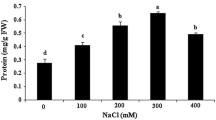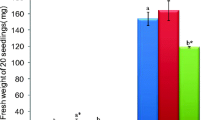Abstract
In order to discriminate between the ionic and osmotic components of salt stress, sugarcane (Saccharum officinarum L. cv. Co 86032) calli were cultured on media containing NaCl or polyethylene glycol (PEG) 8000 that exerted the same osmotic pressure (−0.7 MPa). PEG stress exposure for 15 days led to significant growth reduction and loss in water content than salt stressed and control tissues. Osmotic adjustment (OA) was observed in callus tissues grown on salt, but was not evident in callus grown on PEG. Oxidative damage to membranes, estimated in terms of accumulation of thiobarbituric acid reactive substances-TBARS and electrolytic leakage was significantly higher in both the stressed calli than the control however, the extent of damage was more in the PEG stressed calli. The stressed callus tissues showed inhibition of ascorbate peroxidase activity, while catalase activity was increased. These results indicate sensitivity of cells to PEG-mediated stress than salt stress and differences in their OA to these two stress conditions. The sensitivity to the osmotic stress indicate that expression of the stress tolerance response requires the coordinated action of different tissues in a plant and hence was not expressed at the cellular level.
Similar content being viewed by others
Abbreviations
- 2,4-D:
-
2,4-Dichlorophenoxy acetic acid
- APX:
-
Ascorbate peroxidase (EC 1.11.1.11)
- CAT:
-
Catalase (EC 1.11.1.6)
- DNSA:
-
Dinitro salicylic acid
- EDTA:
-
Ethylene diamine tetra acetic acid
- GB:
-
Glycine betaine
- KI-I2 :
-
Potassium iodide-iodine reagent
- MD:
-
Membrane damage
- MS:
-
Murashige and Skoog basal medium
- NBT:
-
Nitro blue tetrazolium
- OA:
-
Osmotic adjustment
- PFD:
-
Photon flux density
- PVP:
-
Polyvinyl pyrrolidone
- RGR:
-
Relative growth rate
- RH:
-
Relative humidity
- ROS:
-
Reactive oxygen species
- SOD:
-
Superoxide dismutase (EC 1.15.1.1)
- TBA:
-
Thiobarbituric acid
- TBARS:
-
Thiobarbituric acid reactive substances
References
Ahmad MSA, Javed F, Ashraf M (2007) Iso-osmotic effect of NaCl and PEG on growth, cations and free proline accumulation in callus tissue of two indica rice Oryza sativa L. genotypes. Plant Growth Regul 53:53–63
Akhtar S, Wahid A, Rasul E (2003) Emergence, growth and nutrient composition of sugarcane sprouts under NaCl salinity. Biol Plant 46:113–117
Arzani A (2008) Improving salinity tolerance in crop plants: a biotechnological view. In Vitro Cell Devel Biol Plant 445:373–383
Bates LS, Waldren RP, Tears ID (1973) Rapid determination of free proline for water stress studies. Plant Soil 39:205–207
Beyer WF, Fridovich I (1987) Assaying for superoxide dismutase activity: some large consequences of minor changes in condition. Anal Biochem 161:559–566
Bohnert HJ, Jensen RG (1996) Strategies for engineering water stress tolerance in plants. Trends Biotechnol 14:89–97
Bradford MM (1976) A rapid and sensitive method for the quantitation of microgram quantities of protein utilizing the principle of protein-dye binding. Anal Biochem 72:248–254
Cakmak I, Marschner H (1992) Magnesium deficiency and high light intensity enhance activities of superoxide dismutase, ascrobate peroxidase, and glutathione reductase in bean leaves. Plant Physiol 98:1222–1227
Cui XH, Murthy HN, Wu CH, Paek KY (2010) Sucrose-induced osmotic stress affects biomass, metabolite, and antioxidant levels in root suspension cultures of Hypericum perforatum L. Plant Cell Tissue Organ Cult 103:7–14
Desikan R, Cheung MK, Bright J, Henson D, Hancock JT, Neill SJ (2004) ABA, hydrogen peroxide and nitric oxide signaling in stomatal guard cells. J Exp Bot 55:205–212
Errabii T, Gandonou CB, Essalmani H, Abrini J, Idaomar M, Senhaji NS (2007) Effects of NaCl and mannitol induced stress on sugarcane Saccharum sp. callus cultures. Acta Physiol Plant 29:95–102
Glenn EP, Brown JJ, Blueweed E (1999) Salt tolerance and crop potential of halophytes. Crit Rev Plant Sci 18:227–255
Grieve CM, Grattan SR (1983) Rapid assay for determination of water soluble quaternary ammonium compounds. Plant Soil 70:303–307
Heath RL, Packer L (1968) Photoperoxidation in isolated chloroplasts I—kinetics and stoiciometry of fatty acid peroxidation. Arch Biochem Biophys 125:189–198
Imlay JA (2003) Pathways of oxidative damage. Annu Rev Microbiol 57:395–418
Iskandar HM, Casu RE, Fletcher AT, Schmidt S, Xu J, Maclean DJ, Manners JM, Bonnett GD (2011) Identification of drought-response genes and a study of their expression during sucrose accumulation and water deficit in sugarcane culms. BMC Plant Biol 11:12
Jones A (2000) Does the plant mitochondrion integrate cellular stress and regulate programmed cell death? Trends Plant Sci 5:273–278
Khedr AHA, Serag MS, Nemat-Alla MM, Abo-Elnaga AZ, Nada RM, Quick WP, Abogadallah GM (2011) A DREB gene from the xero-halophyte Atriplex halimus is induced by osmotic but not ionic stress and shows distinct differences from glycophytic homologues. Plant Cell Tissue Organ Cult. doi:10.1007/s11240-010-9906-2
Kumar S, Naidu KM, Sehtia HJ (1994) Causes of growth reduction in elongating and expanding leaf tissue of sugarcane under saline conditions. Aust J Plant Physiol 21:79–83
Lingle SE, Wiegand CL (1997) Soil salinity and sugarcane juice quality. Field Crop Res 54:259–268
Lingle SE, Wiedenfeld RP, Irvine JE (2000) Sugarcane response to saline irrigation water. J Plant Nutr 23(4):469–486
Lokhande VH, Nikam TD, Penna S (2010) Biochemical, physiological and growth changes in response to salinity in callus cultures of Sesuvium portulacastrum L. Plant Cell Tissue Organ Cult 102:17–25
Lokhande VH, Nikam TD, Patade VY, Ahire ML, Suprasanna P (2011) Effects of optimal and supra-optimal salinity stress on antioxidative defence, osmolytes and in vitro growth responses in Sesuvium portulacastrum L. Plant Cell Tissue Organ Cult 104:41–49
Lutts S, Kinet JM, Bouharmont J (1995) Changes in plant response to NaCl during development of rice Oryza sativa L. varieties differing in salinity resistance. J Exp Bot 46:1843–1852
Munns R, Tester M (2008) Mechanisms of salinity tolerance. Annu Rev Plant Biol 59:651–681
Murashige T, Skoog F (1962) A revised medium for rapid growth and bioassays with tobacco tissue culture. Physiol Plant 15:473–479
Nakano Y, Asada K (1981) Hydrogen peroxide is scavenged by ascorbate-specific peroxidase in spinach chloroplasts. Plant Cell Physiol 22:867–880
Neill S, Desikan R, Hancock J (2002) Hydrogen peroxide signaling. Curr Opin Plant Biol 5:388–395
Pan Z, Zhu S, Guan R, Deng X (2010) Identification of 2,4-D-responsive proteins in embryogenic callus of Valencia sweet orange (Citrus sinensis Osbeck) following osmotic stress. Plant Cell Tissue Organ Cult 103:145–153
Patade VY, Suprasanna P, Bapat VA (2008) Effects of salt stress in relation to osmotic adjustment on sugarcane (Saccharum officinarum L.) callus cultures. Plant Growth Regul 55:169–173
Patade VY, Bhargava S, Suprasanna P (2011) Salt and drought tolerance of sugarcane under iso-osmotic salt and water stress: growth, osmolytes accumulation and antioxidant defense. J Plant Interact. doi:10.1080/17429145.2011.557513 (in press)
Rossouw D, Bosch S, Kossmann J, Botha FC, Groenewald JH (2007) Down regulation of neutral invertase activity in sugarcane cell suspension cultures leads to a reduction in respiration and growth and an increase in sucrose accumulation. Funct Plant Biol 34:490–498
Sabbah S, Tal M (1990) Development of callus and suspension cultures of potato resistant to NaCl and mannitol and their response to stress. Plant Cell Tissue Organ Cult 21:119–128
Sharma P, Dubey RS (2005) Drought induces oxidative stress and enhances the activities of antioxidant enzymes in growing rice seedlings. Plant Growth Regul 46:209–221
Sorkheh K, Shiran B, Khodambshi M, Rouhi V, Ercisli S (2011) In vitro assay of native Iranian almond species (Prunus L. spp.) for drought tolerance. Plant Cell Tissue Organ Cult 105:395–404
Sun J, Li L, Liu M, Wang M, Ding M, Deng S, Lu C, Zhou X, Shen X, Zheng X et al (2010) Hydrogen peroxide and nitric oxide mediate K+/Na+ homeostasis and antioxidant defense in NaCl-stressed callus cells of two contrasting poplars. Plant Cell Tissue Organ Cult 103:205–215
Verslues PE, Agarwal M, Katiyar-Agarwal S, Zhu J, Zhu JK (2006) Methods and concepts in quantifying resistance to drought, salt and freezing, abiotic stresses that affect plant water status. Plant J 45:523–539
Wahid A (2004) Analysis of toxic and osmotic effects of sodium chloride on leaf growth and economic yield of sugarcane. Bot Bull Acad Sinica 45:133–141
Wahid A, Rao AR, Ejaz R (1997) Identification of salt tolerance traits in sugarcane lines. Field Crop Res 541:9–17
Watanabe S, Kojima K, Ide Y, Sasaki S (2000) Effects of saline and osmotic stress on proline and sugar accumulation in Populus euphratica in vitro. Plant Cell Tissue Org Cult 63:199–206
Wiedenfeld B (2008) Effects of irrigation water salinity and electrostatic water treatment for sugarcane production. Agric Water Manag 95:85–88
Xu X, Shi G, Wang J, Zhang L, Kang Y (2011) Copper-induced oxidative stress in Alternanthera philoxeroides callus. Plant Cell Tissue Organ Cult. doi:10.1007/s11240-010-9914-2
Yancey PH, Clark MB, Hands SC, Bowlus RD, Somero GN (1982) Living with water stress: evaluation of osmolytes systems. Science 217:1214–1222
Yeo A (1998) Molecular biology of salt tolerance in the context of the whole-plant physiology. J Exp Bot 49:915–929
Acknowledgments
The senior author is grateful to the University Grant Commission, New Delhi and Botany Department, University of Pune, Pune for award of a UGC Research fellowship.
Author information
Authors and Affiliations
Corresponding author
Rights and permissions
About this article
Cite this article
Patade, V.Y., Bhargava, S. & Suprasanna, P. Effects of NaCl and iso-osmotic PEG stress on growth, osmolytes accumulation and antioxidant defense in cultured sugarcane cells. Plant Cell Tiss Organ Cult 108, 279–286 (2012). https://doi.org/10.1007/s11240-011-0041-5
Received:
Accepted:
Published:
Issue Date:
DOI: https://doi.org/10.1007/s11240-011-0041-5




